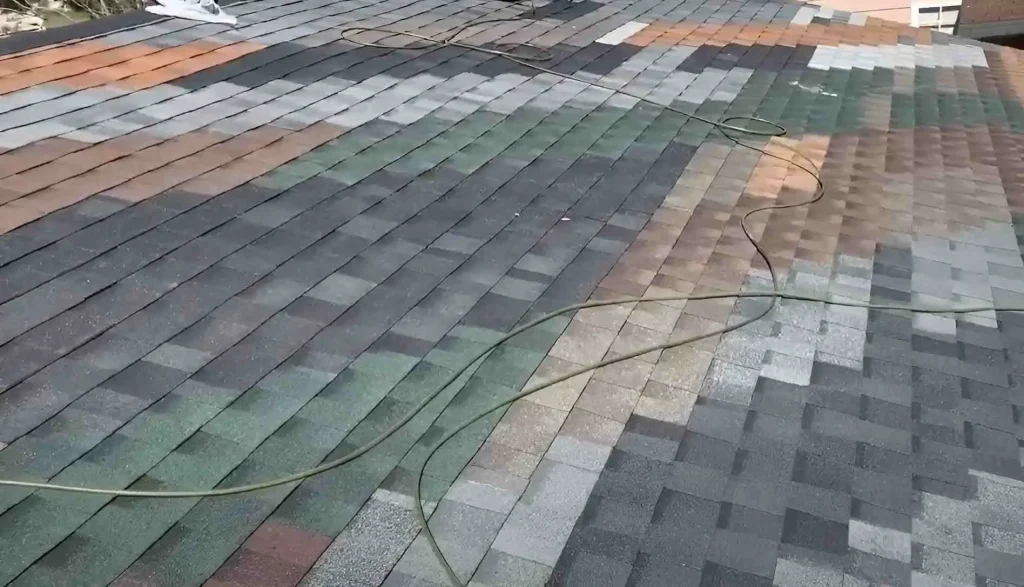Installing a new roof is a significant investment in your home, one that should enhance its appearance and functionality. However, there are times when new roof shingles don’t match the existing ones, leading to a less-than-ideal situation. In this article, we’ll explore why this issue can occur, its impact on your home, and what steps you can take to address it.

Understanding the Importance of Shingle Matching
The Aesthetic Aspect
Roof shingles are a visible and prominent part of your home’s exterior. When they don’t match, it can significantly impact your home’s overall appearance. Mismatched shingles can make your roof look unattractive and disrupt the visual harmony of your property.
Weather Resistance and Functionality
Aside from aesthetics, roof shingles play a critical role in protecting your home from the elements. When shingles don’t match, it can lead to issues with water runoff and weather resistance. Gaps between shingles or misaligned patterns can compromise the integrity of your roof.
Reasons for Mismatched Shingles
Several reasons can lead to new roof shingles not matching the existing ones:
1. Different Batches
Manufacturers may produce shingles in different batches, resulting in slight variations in color or texture. Even when you order shingles with the same specifications, batch differences can lead to mismatched shingles.
2. Fading Over Time
Exposure to sunlight and weather can cause shingles to fade and change color over time. If your existing shingles have weathered significantly, newly installed shingles may appear noticeably different.
3. Repairs and Patchwork
If your roof has undergone repairs or patchwork in the past, it’s possible that the replacement shingles used at those times don’t match the original ones.
4. Contractor Errors
In some cases, the mismatch may result from errors made during the installation process. This could include incorrect shingle selection or improper installation techniques.
What to Do When New Roof Shingles Don’t Match
1. Consult with Your Contractor
If you notice that the shingles don’t match during or immediately after the installation, it’s essential to consult with your roofing contractor. They should address the issue promptly and discuss potential solutions.
2. Request a Roof Inspection
If the mismatch becomes apparent after some time, it’s a good idea to request a roof inspection from a professional roofing contractor. They can assess the extent of the problem and determine the cause.
3. Review Your Warranty
Check your roofing warranty to see if it covers issues related to shingle matching. Some warranties may provide protection against color discrepancies or batch differences.
4. Consider Replacement or Repairs
Depending on the severity of the mismatch, you may need to consider replacement or repair options. In some cases, replacing the entire roof may be the best solution, while in others, selectively replacing shingles may suffice.
5. Color Blending Techniques
Roofing professionals can use color blending techniques to minimize the visual impact of mismatched shingles. These techniques involve strategically placing mismatched shingles to create a more harmonious look.
Preventing Mismatched Shingles in the Future
To prevent the issue of new roof shingles not matching existing ones in the future, consider these steps:
1. Proper Planning
Before starting a roofing project, discuss the importance of shingle matching with your contractor. Ensure they understand your expectations and the need for color consistency.
2. Material Selection*
Choose roofing materials with a proven track record of color consistency. Some manufacturers offer advanced technologies that minimize color variations between batches.
3. Quality Installation*
Hire experienced and reputable roofing contractors who follow best practices in installation. Proper installation techniques can help prevent color discrepancies and ensure a consistent appearance.
Conclusion
Mismatched roof shingles can be an aesthetic and functional concern for homeowners. Whether due to different batches, fading, or previous repairs, addressing the issue promptly is essential. Consult with your roofing contractor, explore your warranty, and consider repair or replacement options to ensure your roof maintains its integrity and visual appeal. By taking preventive measures during the planning and material selection phases of your roofing project, you can reduce the likelihood of encountering the problem of new roof shingles not matching the existing ones in the future.



Leave a Reply